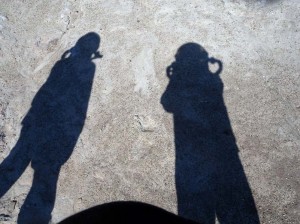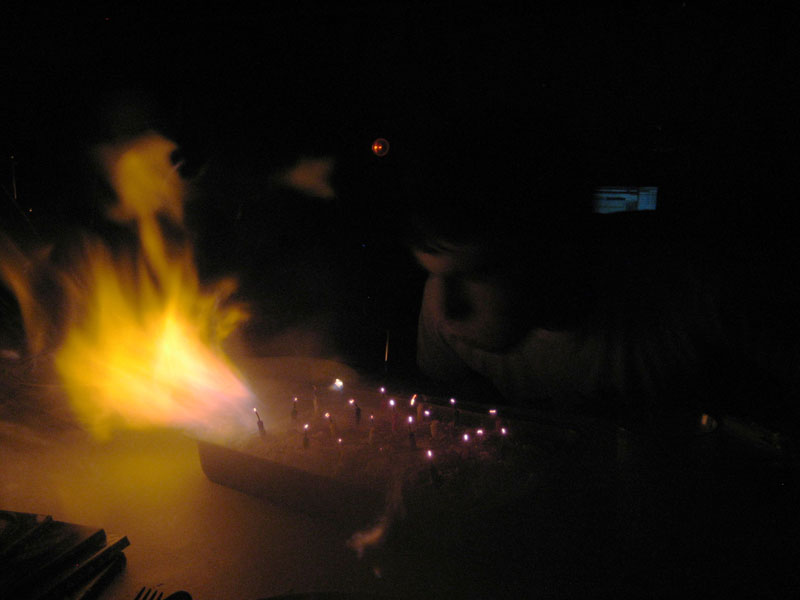While out on an EVA today, Darrel broke his leg. He had someone with him, of course—in this case, Mike—who was able to radio back to the Hab about the accident and request emergency assistance. Brian, Carla, and Kiri quickly suited up, and Luis remained behind to serve as HabCom and monitor our progress via radio. Twenty-one minutes later, we were exiting the airlock and on our way to rescue our downed crew member.
Lest the reader be overly anxious at this point, I should explain that Darrel didn’t really break his leg. We had decided to test our ability to respond to an emergency in which one crew member was unable to move. Carla and Brian spent the morning constructing a sled that could be used to drag someone back to the Hab behind an ATV. When the emergency call came in at 3:04 p.m., we all leapt into action. I plugged the coordinates that Mike reported into my GPS unit (fumbling a bit as I hadn’t ever tried to enter coordinates manually before—lesson learned!). We suited up in record time (13 minutes). Outside, Brian attached the sled to the Viking-1 ATV and kicked it into gear. Carla and I trailed along in his wake, on foot.We had stepped out into a snowy, misty world, where visibility was limited to about a quarter-mile. The sun lit up the fog, shedding silvery light all around us, and the hills were white mounds with patches of red peeking through on the south-facing slopes. Crunching along on the snowy road, we could see that we needed to head northeast to reach Mike and Darrel. The road would be more convenient for the sled, but their footprints led off to the north and we wanted to be sure we could reach them. So we headed off over the lumpy snow. (Our out-of-sim concerns about avoiding off-road ATV use were allayed by the thick layer of snow.) Viking-1 performed heroically, and the sled slid along behind in fine form.
We walked and walked, hoping with each rise that we’d suddenly see Mike and Darrel. But each time we were only rewarded with new views of their twin footprints, leading us onward. Finally, at 3:45 p.m. and about half a mile from the Hab, we crested a larger hill and discovered our fallen comrade, attended by Mike. We couldn’t get the ATV up to the foot of the rocky cliff where he’d “fallen”, so we lifted and carried him down to the ATV and sled. At that point we discovered that we were only about 40 yards from Lowell Highway, so after strapping Darrel to the sled, we continued on to the highway. Turning onto the snow-covered, graded road, we were able to make better time. We were back to the Hab by 4:35 p.m., at which point Darrel was again carried up into the airlock and, after depressurization, Luis was able to attend to his injuries.
A video of the rescue operation is in the works!
Another notable achievement for the day: Darrel and Luis put Viking-2’s carburetor back together and installed it, but so far no luck in starting the ATV. We’ll keep trying.
In the evening, we assembled for our second group exercise session. This time, Luis was our instructor and taught us basic capoeira moves—and wowed us with his advanced spinning and kicking! We all got a good workout (and no doubt entertained any webcam watchers). Now we’re busily filing reports and anticipating a tasty AlpineAir meal: Leonardo da Fettuccine.
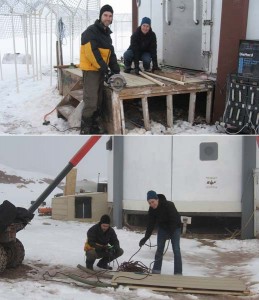
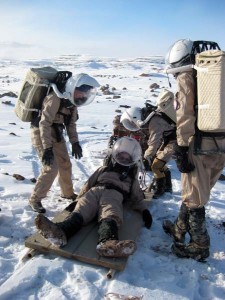


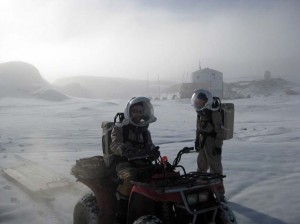
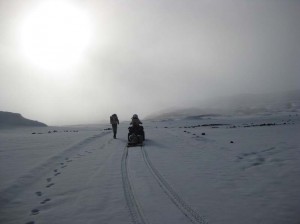
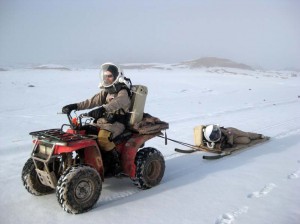


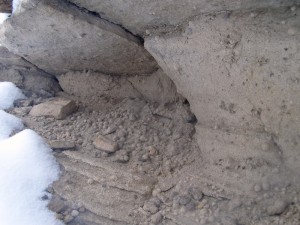
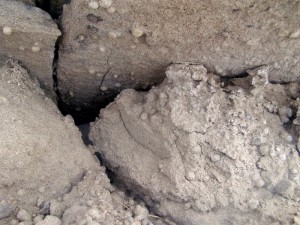
 So, we’ve gotten used to these surroundings in the few days that we’ve been here, especially the upper deck of the Hab. This is where most of the work gets done: filing reports at the end of each day, planning EVAs, cooking, eating, relaxing, and bonding as a team. The space is very multi-purpose, with the main central table serving as both a kitchen table and a workstation (or game table), the kitchen sitting right next to the main workbench, and it allows access to every other part of the Hab.
So, we’ve gotten used to these surroundings in the few days that we’ve been here, especially the upper deck of the Hab. This is where most of the work gets done: filing reports at the end of each day, planning EVAs, cooking, eating, relaxing, and bonding as a team. The space is very multi-purpose, with the main central table serving as both a kitchen table and a workstation (or game table), the kitchen sitting right next to the main workbench, and it allows access to every other part of the Hab.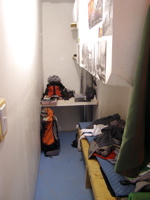
 Our day, however, begins in the state rooms, each of which is composed of nothing more than a bunk and a small desk (and a few have installed shelving). For most of us, these state rooms are just for sleeping and storing anything we can’t leave out in the main room, although Brian and Carla do complete quite a bit of work in their larger rooms as benefit to being our Commander and XO, respectively. While my state room, pictured to the right, is quite messy, it’s more to allow access to anything I may need immediately, hence the spread of supplies on my desk.
Our day, however, begins in the state rooms, each of which is composed of nothing more than a bunk and a small desk (and a few have installed shelving). For most of us, these state rooms are just for sleeping and storing anything we can’t leave out in the main room, although Brian and Carla do complete quite a bit of work in their larger rooms as benefit to being our Commander and XO, respectively. While my state room, pictured to the right, is quite messy, it’s more to allow access to anything I may need immediately, hence the spread of supplies on my desk. Since we are in sim, the only time we can leave the Hab (aside from engineering rounds, which I’ll get too later) is while on EVA, or Extra-Vehicular Activity; those trips start in the EVA Prep Room, pictured to the right. Here is where we store everything that is needed for an EVA, at least everything that can be carried that isn’t specifically engineering related. During the suit-up procedure, the Marsonauts first put on their flight suits (hanging in the background). When we first arrived at MDRS, we tried on the suits until we found one that would fit, then Velcro-ed our mission patch and name tags onto our selected flight suits. They then don their boots and waders, along with their radios and headsets. At this point, their is usually also a com check between the Marsonauts and HabCom (the person who stays behind to communicate with those on the surface) before the suit-up procedure progresses.
Since we are in sim, the only time we can leave the Hab (aside from engineering rounds, which I’ll get too later) is while on EVA, or Extra-Vehicular Activity; those trips start in the EVA Prep Room, pictured to the right. Here is where we store everything that is needed for an EVA, at least everything that can be carried that isn’t specifically engineering related. During the suit-up procedure, the Marsonauts first put on their flight suits (hanging in the background). When we first arrived at MDRS, we tried on the suits until we found one that would fit, then Velcro-ed our mission patch and name tags onto our selected flight suits. They then don their boots and waders, along with their radios and headsets. At this point, their is usually also a com check between the Marsonauts and HabCom (the person who stays behind to communicate with those on the surface) before the suit-up procedure progresses.  Once everything checks out, they then strap into their PLSS (Portable Life Support System), usually with the help of someone in the ready room. This backpack allows the EVA personnel to survive outside of the Hab as it filters and transfers breathable air to the helmet, which is put on next. A final check is made before the Marsonauts enter the airlock, where they must wait for five minutes for depressurization, before leaving the Hab and stepping out onto the surface. Once they return, this process is repeated in reverse, usually followed by a hot meal for the returning explorers.
Once everything checks out, they then strap into their PLSS (Portable Life Support System), usually with the help of someone in the ready room. This backpack allows the EVA personnel to survive outside of the Hab as it filters and transfers breathable air to the helmet, which is put on next. A final check is made before the Marsonauts enter the airlock, where they must wait for five minutes for depressurization, before leaving the Hab and stepping out onto the surface. Once they return, this process is repeated in reverse, usually followed by a hot meal for the returning explorers. During the day, a lot of the work is completed in the lower deck, which includes the EVA Prep Room, main airlock, Biology and Geology labs, engineering bay and airlock, as well as the bathroom and shower. Since our completed EVAs (four in total) haven’t been centered on either Biology and Geology, the main lab area (pictured) has mostly just been inventoried and cleaned by LuÃs, our Biologist. There is an EVA out currently that focuses on geology and geophysics, plus there is a planned EVA later today centered on biology, so this area will mostly likely being in use more for the rest of the mission. Darrel, our Engineer, is also using the area as an interior engineering bay and repair station for basically the entire Hab.
During the day, a lot of the work is completed in the lower deck, which includes the EVA Prep Room, main airlock, Biology and Geology labs, engineering bay and airlock, as well as the bathroom and shower. Since our completed EVAs (four in total) haven’t been centered on either Biology and Geology, the main lab area (pictured) has mostly just been inventoried and cleaned by LuÃs, our Biologist. There is an EVA out currently that focuses on geology and geophysics, plus there is a planned EVA later today centered on biology, so this area will mostly likely being in use more for the rest of the mission. Darrel, our Engineer, is also using the area as an interior engineering bay and repair station for basically the entire Hab. Speaking of engineering, the Hab also requires a power supply separate from the Hab and its vicinity. In a future Martian habitat, this power station will be much more than a diesel engine, so it needs to be separated from the Hab for the safety of the astronauts. During engineering rounds, Darrel and usually one other member of the crew (recently it has been either Kiri or Carla) check the power supply, batteries, ATVs, general Hab upkeep, Green Hab (which is both a greenhouse and a water recycling facility), and the various systems that are required in order to keep everything running smoothly. During a typical day, rounds are made in the morning (following the meeting) and at night before our mission support window opens at 2000 Local Time. This gives the engineer enough time to make the measurements and other checks, fix anything that needs fixing, and file a report so that (for any major problems), Mission Support can help troubleshoot things.
Speaking of engineering, the Hab also requires a power supply separate from the Hab and its vicinity. In a future Martian habitat, this power station will be much more than a diesel engine, so it needs to be separated from the Hab for the safety of the astronauts. During engineering rounds, Darrel and usually one other member of the crew (recently it has been either Kiri or Carla) check the power supply, batteries, ATVs, general Hab upkeep, Green Hab (which is both a greenhouse and a water recycling facility), and the various systems that are required in order to keep everything running smoothly. During a typical day, rounds are made in the morning (following the meeting) and at night before our mission support window opens at 2000 Local Time. This gives the engineer enough time to make the measurements and other checks, fix anything that needs fixing, and file a report so that (for any major problems), Mission Support can help troubleshoot things.
